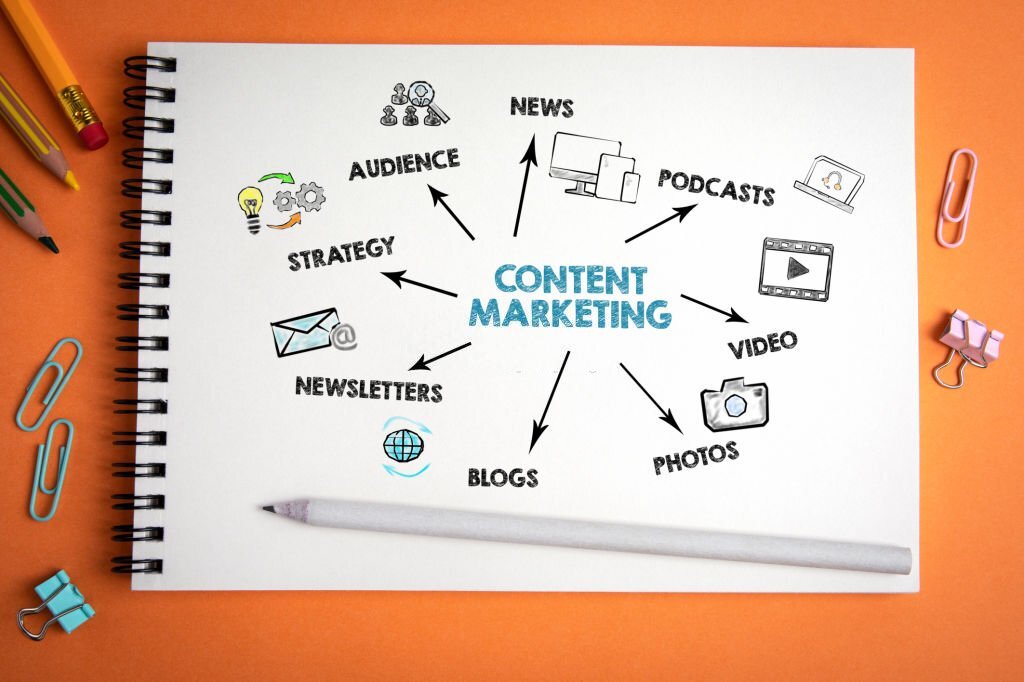
In a world where there’s an overload of information and marketing messages, it is increasingly challenging to attract the target audience. Having well-thought-out, unique and interesting content is the best way to stand out in a crowded marketplace and get noticed.
Content marketing is increasingly becoming an essential part of brands that want to succeed. It has taken over the marketing industry like a storm. But, what does content marketing mean? How does one go about content marketing? It is possible to create great content by yourself, but that can take time. Here’s a step-by-step content marketing guide that takes you through the different stages of content marketing.
Introduction to Content Marketing 2022
We live in an ever-evolving digital marketing era, where we need to keep up with every marketing method. It is a wise strategy to create and distribute valuable, relevant, and quality content that speaks to your target audience. The clear benefit of this approach is that you’re more likely to retain your customers’ interests and align with their particular interests so they’ll take action on what you’re giving them.
Content marketing should not be confused with other marketing activities, such as product marketing or advertising. Content marketing is one of the most effective strategies that focus on building a relationship with your customers and providing them with the information they seek.
The core reason to go with content marketing is to:
- Attract a defined target audience.
- Generate leads and sales.
- Turn that audience into customers.
- Engage and educate them.
Importance of Content Marketing
Everyone knows that Content is King. Quality content not only attracts customers but also retains them. One of the most beneficial elements of content marketing for a business is that it’s so accessible. It’s not tough to know how to create and promote it effectively, making it even more attractive. Here are some of the key importance of implementing a well-thought-out content marketing plan:
It Improves Search Engine Visibility
Content marketing is the key to increasing visibility through search engines. By creating high-quality, keyword-rich content, you can attract a consistent stream of traffic to your website. In addition, regular updates to your content will keep your site fresh, and the search engine will eventually rank you higher.
It Builds Brand Awareness
Content marketing can help build brand awareness in several ways. It can help create a favorable impression of the brand in the minds of consumers. It can also help keep the brand top-of-mind for consumers, so they are more likely to think of the brand when ready to purchase. Moreover, content marketing can help build trust between the consumer and the brand.
It Drives Direct Conversions
Content marketing drives direct conversions by providing relevant and valuable information that helps lead a prospect through the buyer’s journey. By nurturing prospects with targeted content, you can create a relationship of trust that ultimately leads to a sale.
Perhaps the most direct way to drive conversions is through gated content. Gated content is behind a paywall or requires some sort of registration to view it. And that’s what a professional SEO services agency does. By doing this, you’ll know which people are interested in the content you publish, which can often lead to conversions as those interested parties are more likely to take action.
Another way that content marketing can drive direct conversions is by including calls-to-action (CTAs) within the content itself. You can provide a link to your landing page where people can sign up for a newsletter. By including CTAs, you’re essentially giving readers a nudge in the right direction, which can often lead to conversions.
It Increases Online Traffic
Content marketing can increase site traffic by improving your site’s search engine optimization (SEO). By creating high-quality content that is keyword-rich and link-worthy, you can improve your site’s ranking in search engine results pages, leading to more traffic. Additionally, you can reach a larger audience and generate more traffic by promoting your content through social media and other channels.
Furthermore, content marketing helps you implement a strategic guest posting approach. This is an extremely important approach for exposing your business to new prospects who happen to be relevant to your area of expertise.
It Increases Retention Rate
Content marketing is a key driver of customer retention rates. By delivering high-quality, targeted content to your audience regularly, you can keep them engaged and interested in your brand. This will give you increased customer satisfaction and retention rates. Additionally, content marketing can help you improve your customer service and increase customer loyalty.
Now that you are aware of the importance of content marketing, let’s get right into the most effective tips on how to implement a solid content marketing strategy that delivers rapid results:
Content Marketing Strategy Implementation Guide 2022
Every business, large or small, is trying to figure out how to use content marketing to get more customers, create more leads and make more sales. This guide cuts through the mystery of how to use content marketing to see how you can use this tool to grow your business and turn it into a brand.
Establish Your Content Marketing Goals
Before you create content that will help you reach your target audience, you need to establish clear goals for your content marketing strategy.
Your goals should be specific, achievable, measurable, time-bound, and relevant. This means you should clearly understand what you want your content to achieve, how you would measure your success, what your target audience is, and what timeline you’re working with.
Once you’ve established your content marketing goals, it’s time to develop your content strategy. Your content strategy should include your target audience, your brand’s unique voice and style, the topics you’ll cover, the types of content you’ll create, the overall tone and message of your content, the keywords and SEO phrases you’ll target, the distribution channels you’ll use, and the metrics you’ll use to measure your success.
If you’re not certain where to take the leap, look at your competitors’ content and look for gaps and opportunities.
Determine Your Target Audience
This is an important step in content marketing, as it will help you focus your content and ensure that it is relevant to your target audience. Once you know your target audience, you can tailor your content to meet their needs and interests. Targeting the right audience is essential since it is the group of people you want to reach with your content marketing.
To determine your target audience, consider who you want to reach with your content, their needs and interests, and where they are in the buyer’s journey. Use surveys, questionnaires, and focus groups to get feedback on what kinds of content would be most useful or interesting to them.
What content is your competition producing? What’s working well for them? Whether you are planning to hire digital marketing services or willing to go on your own, identifying your competition is important. It helps to create content that differentiates you from the rest.
Produce Engaging Yet Quality Content
If you engage in content marketing without first ensuring that your content is high quality, you will likely find that your efforts are not very effective. In order to capture the attention of your targeted audience, it also needs to be well-written and free of errors to give your brand a professional appearance. Take the time to produce engaging yet quality content before you begin your content marketing campaign, and you’ll be more likely to achieve your goals.
You also need to ensure that you’re producing SEO-friendly content because almost 35% of online traffic comes from organic searches. SEO-friendly content is the key to successful content marketing. By streamlining your substance for web crawlers, you can ensure that your content will be seen by a wider audience and generate more traffic to your website.
To create SEO-friendly content, you should focus on creating informative and keyword-rich content relevant to your target audience.
Distribution of Content
Delivering one seamless brand experience to your audience is one of the best ways to make your business memorable. Aligning the brand messaging and goals across various channels enables this, as audiences will know what you can offer them. The more Omnichannel contact points in place, the better it is for your customers!
Providing Omnichannel communication is like heating someone’s toes on a cold day. It makes them feel warm and cozy, which will make your brand top-of-mind. Adhering to Omnichannel communication (aka hit up customers through all the available mediums) will help you stay consistent in terms of the way that you market and communicate, essentially telling customers about all your wonderful offerings in one fell swoop, which means you won’t have to stress about different platforms and then set priorities when choosing where to focus.
Don’t Underestimate the Power of Social Media.
Many businesses ignore the power of social media. Creating a true social media presence will help you determine your goals and objectives, target audience, and what kind of content they seek. Once you have a strategy in place, you can start creating content relevant to your audience on social media platforms.
With over 3.4 billion global social media users, not a single business owner intends to miss this opportunity to promote the products and services. Some social media content marketing ideas include creating blog posts, infographics, videos, and even podcasts. You can also share your content on social media platforms like Facebook, Twitter, and LinkedIn. The key is to make interesting and informative content so that your audience shares it willingly with friends and followers.
Analyze & Monitor the Content Performance
There are a few key ways to analyze your content performance:
- Check your website traffic. Use Google Analytics or another web traffic analysis tool to see how much traffic your website gets. Analyze where you get the most of your traffic (referrals, social media, direct, etc.) and what pages on your site are viewed the most.
- Check your social media engagement. Use a tool like Hootsuite Insights or Sprout Social to see how much engagement your posts are getting on social media. Check the number of shares, likes, and comment each post receives.
- Check your email open rates. If you’re sending out newsletters or other email content, check your open rates to determine how many people read your emails.
- Check your click-through rates. If you include links in your content, check your click-through rates to see how many people click on those links.
- Check your conversion rates. If you have goals set up on your website (such as newsletter sign-ups or e-commerce sales), check your conversion rates to see how many people are taking the desired action.
These are just a few key ways to measure and analyze your content performance. By tracking these metrics, you’ll see what’s working well and what could be improved.
Wrapping Up
We created this step-by-step guide to serve as a quick reference for those with SEO skills and those who are also looking to use content marketing smartly. You can come up with great ideas, but there’s more to creating useful content than interesting ideas.
There are many years of experience behind the successful placements that you see ranking high on search engine results pages. Over time, you’ll learn how to make the most out of your marketing efforts; the only problem is that Google keeps changing its algorithms! All you need to do is take the advice mentioned above into consideration.





